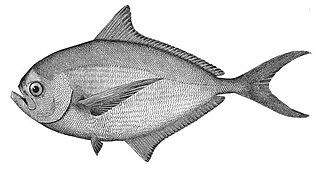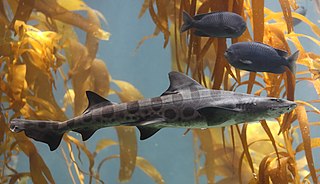
The Percidae are a family of ray-finned fish, part of the order Perciformes, which are found in fresh and brackish waters of the Northern Hemisphere. The majority are Nearctic, but there are also Palearctic species. The family contains more than 200 species in 11 genera. The perches and their relatives are in this family; well-known species include the walleye, sauger, ruffe, and three species of perch. However, small fish known as darters are also a part of this family.

Characidae, the characids or characins, is a family of freshwater subtropical and tropical fish belonging to the order Characiformes. The name "characins" is a historical one, but scientists today tend to prefer "characids" to reflect their status as a, by and large, monophyletic group. To arrive there, this family has undergone much systematic and taxonomic change. Among those fishes remaining in the Characidae currently are the tetras, comprising the very similar genera Hemigrammus and Hyphessobrycon, as well as a few related forms, such as the cave and neon tetras. Fish of this family are important as food in several regions, and also constitute a large percentage of captive freshwater aquarium fish species.

The mullets or grey mullets are a family (Mugilidae) of ray-finned fish found worldwide in coastal temperate and tropical waters, and some species in fresh water. Mullets have served as an important source of food in Mediterranean Europe since Roman times. The family includes about 78 species in 26 genera.

Pomfrets are scombriform fish belonging to the family Bramidae. The family currently includes 20 species across seven genera. Several species are important food sources for humans, especially Brama brama in South Asia. The earlier form of the pomfret's name was "pamflet", a word which probably ultimately comes from Portuguese pampo, referring to various fish such as the blue butterfish. The fish meat is white in color.

The Triakidae or houndsharks are a family of ground sharks, consisting of about 40 species in nine genera. In some classifications, the family is split into two subfamilies, with the genera Mustelus, Scylliogaleus and Triakis in the subfamily Triakinae, and the remainders in the subfamily Galeorhininae.

The Percophidae, duckbills, are a family of percomorph fishes, from the order Trachiniformes, found in tropical and subtropical waters of the Atlantic and Indian Oceans and in the southwestern and southeastern Pacific.

The Gobiiformes are an order of fish that includes the gobies and their relatives. The order, which was previously considered a suborder of Perciformes, is made up of about 2,211 species that are divided between seven families. Phylogenetic relationships of the Gobiiformes have been elucidated using molecular data. Gobiiforms are primarily small species that live in marine water, but roughly 10% of these species inhabit fresh water. This order is composed chiefly of benthic or burrowing species; like many other benthic fishes, most gobiiforms do not have a gas bladder or any other means of controlling their buoyancy in water, so they must spend most of their time on or near the bottom. Gobiiformes means "goby-like".
Gerald Robert "Gerry" Allen is an American-born Australian ichthyologist. His career began in 1963, when he spent a semester at the University of Hawaii, where he also received a PhD in marine zoology in 1971. In 1972, Allen wrote his doctoral thesis on the systematics and biology of the anemone fish.

Pteropsaron is a genus of ray-finned fish in the family Hemerocoetidae.
Catalog of Fishes is a comprehensive on-line database and reference work on the scientific names of fish species and genera. It is global in its scope and is hosted by the California Academy of Sciences. It has been compiled and is continuously updated by the curator emeritus of the CAS fish collection, William N. Eschmeyer.
Acropoma hanedai is a species of ray-finned fish, a lanternbelly from the family Acropomatidae. It occurs in the north-western Pacific Ocean from southern Japan to Taiwan. It is a food fish which is caught by trawling.

Acanthaphritis is a genus of ray-finned fish which are part of the family Hemerocoetidae. They have an Indo-Pacific distribution.
Dactylopsaron is a monotypic genus of ray-finned fish from the family Hemerocoetidae. The only species in the genus, Dactylopsaron dimorphicum is found in the eastern South Pacific on the Salas y Gomez ridge and the adjacent part of the Nazca Ridge.
Enigmapercis is a genus of ray-finned fish which are part of the family Hemerocoetidae. They have an Indo-Pacific distribution.

Matsubaraea is a monotypic genus of ray-finned fish from the family Hemerocoetidae. The only species in the genus, Matsubaraea fusiforme is found in the western Pacific in the waters around Japan, Thailand and the Philippines on sandy substrates. It feeds on mysids. The generic name honours the Japanese ichthyologist Shinnosuke Matsubara who was director of Imperial Fisheries in Tokyo.
Squamicreedia is a genus of ray-finned fishes from the family Hemerocoetidae. It is endemic to waters with sandy sea beds off northern Australia. It is a monotypic genus, containing a single species, Squamicreedia obtusa, the obtuse duckbill or obtuse sandfish.
Creedia alleni is a species of sandburrowers found in the Eastern Indian Ocean in Australia. This species reaches a length of 4 cm (1.6 in).
Creedia bilineata is a species of sandburrowers found in the Northwest Pacific Ocean around Japan. This species reaches a length of 3.2 cm (1.3 in).
Creedia haswelli, the slender sandburrower, is a species of marine ray-finned fish belonging to the family Creediidae, the sandburrowers. This species is found in Southern Australia. This species reaches a length of 7.5 cm (3.0 in).
Epigonus elongatus is a species of deepwater cardinalfish found in the Western Indian Ocean mainly north of Madagascar and quite near the Seychelles. This fish occurs at depths of 300 m (980 ft).










